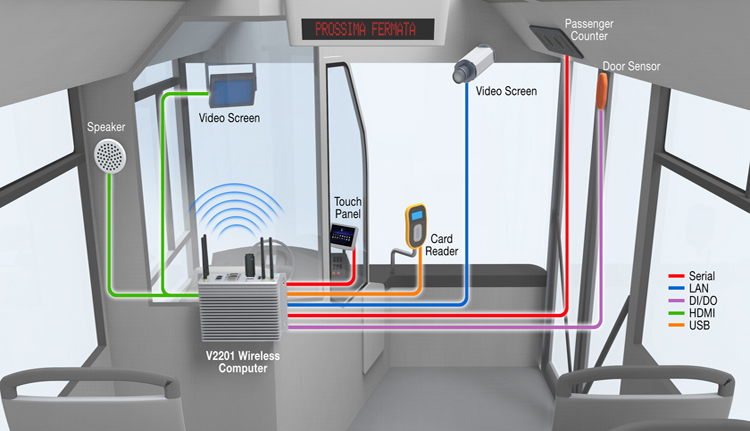Visit www.excelnex.com
|
Use LTE Enabled Industrial Computers to Make Intellegence Bus Even Smarter
Built-in computers that connect wirelessly to the internet are a standard feature of a new generation of intelligent buses. High-performance computers are required for this job, because they must be able to handle multiple tasks at the same time, including control, data collection, monitoring, and data transmission. The automated doors are controlled by the computer through DI/DO interfaces. Passengers are automatically counted as they enter and leave the bus, and passenger flow data can be stored for later analysis. The onboard IP cameras send video to the computer for storage and for real time display on the driver’s panel, to assure passengers’ safety. The card reader processes the ticket info, calculates the price, updates the card, and sends the information back to the control center. All these jobs can now be handled by a palm-size industrial computer. It may appear that these functions and the data gathered only affect the individual bus and its passengers, but in fact, wider benefits are possible by linking the bus wirelessly to a larger network. The wireless computer records GPS data and sends its current location to the control center. Meanwhile, passenger data can be used to let commuters waiting at bus stops know when there are vacant seats on upcoming buses. As well as analyzing the information gathered by the computer to optimize bus scheduling, it can also be provided immediately to potential passengers through real-time bus information displays at bus stops or and smart phone apps. When this information can be shared in real time, improving the bus passenger’s experience becomes easier. Because space is limited in a bus, a very compact embedded system is a must. In addition, the system needs to be shock and vibration-resistant to provide reliable live voice and data communication to the remote control center. A variety of wireless connection modes also helps reduce costs, as a bus has to travel all over the city, and multiple wireless options make it easier to connect to variety of different devices in different situations.
• Compact size with rich communications capabilities Moxa’s new LTE-enabled V2201 wireless computers ensures reliable system operation in temperatures ranging from -40 to 70°C to help you avoid system crash or unstable situation from extreme temperature variation. The small palm size design (150 x 48.8 x 120.2 mm) is fanless, and support both DIN-rail and wall mounting capability, making installation and maintenance easy. The versatile communication infrastructure and storage expansion design allow users don’t need to worry that storage limitations and complex communication demand. Rugged, Flexible and wireless enabled make V2201 your most reliable partner in industrial IoT applications.
• Fanless palm size design (150 x 48.8 x 120.2 mm) allows easy installation almost anywhere onboard.
|
|||
|---|---|---|---|
About ExcelNex I Products I Contact I Sitemap |
Copyrights © 2015 ExcelNex Integrated Sdn Bhd |
